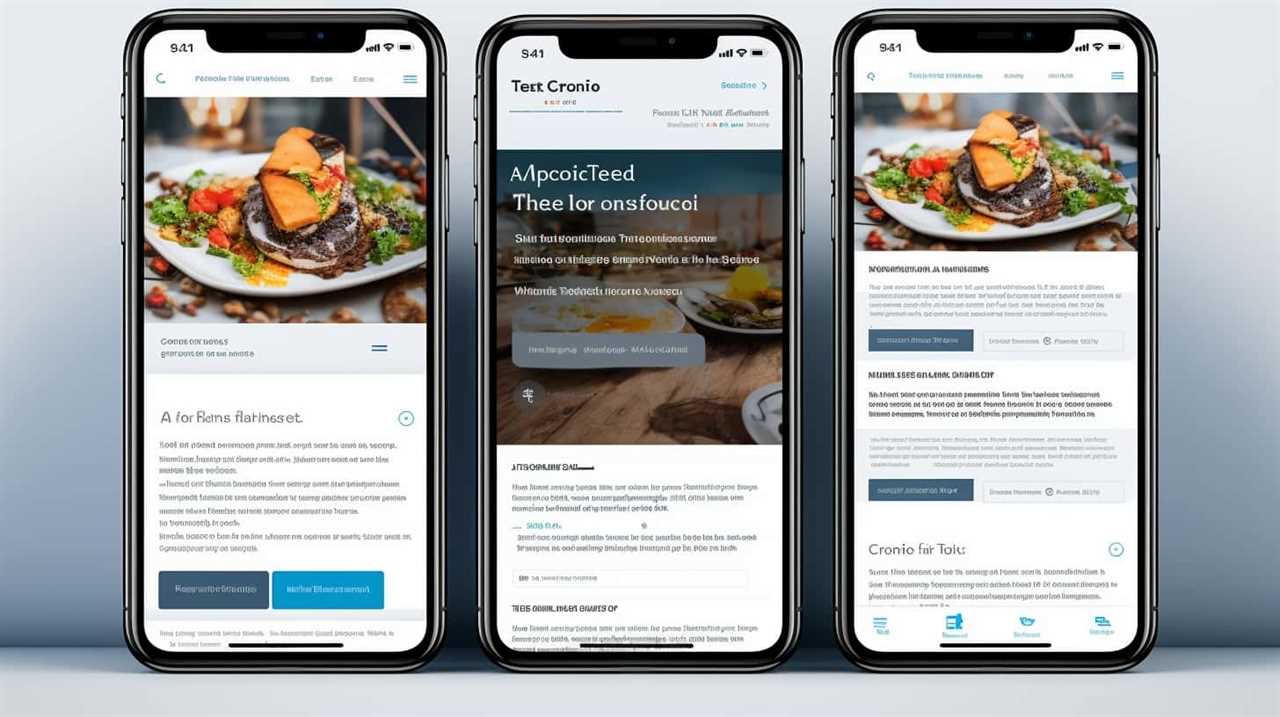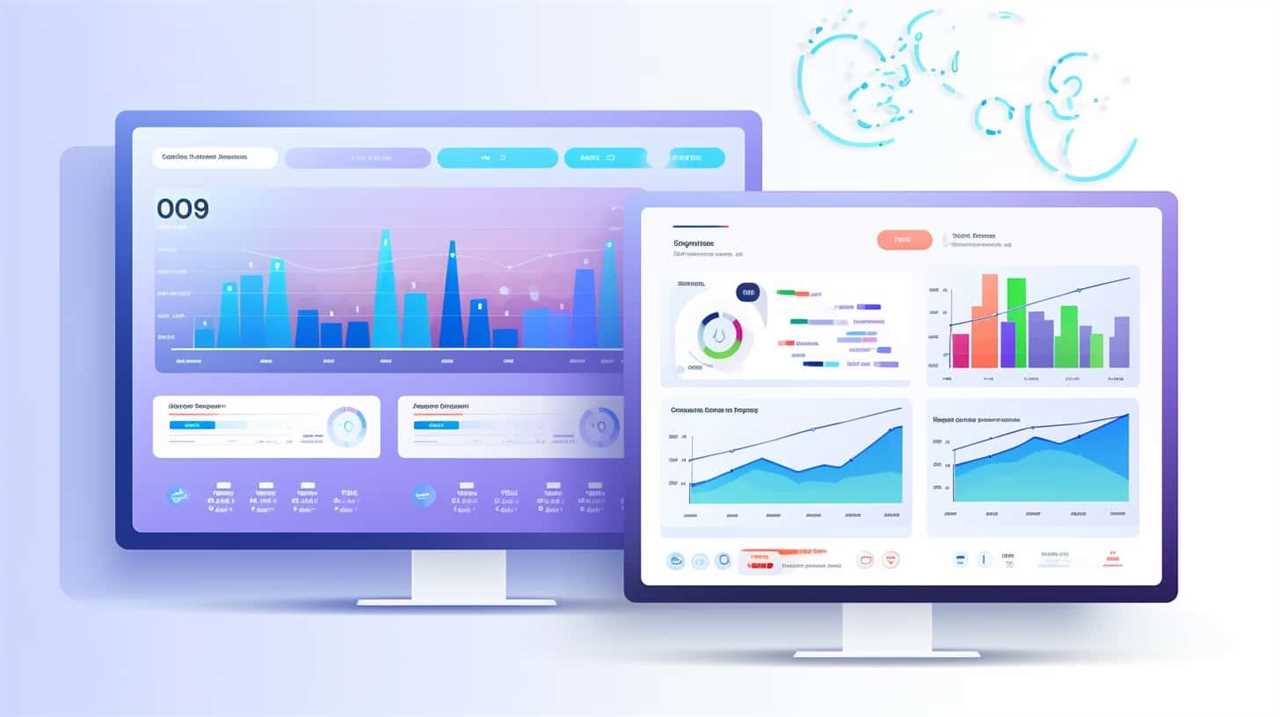Expert Content Authority
9 Steps to Increase Topical Authority With Regular Updates

Are you concerned that your digital footprint isn’t growing as you had anticipated? We have the perfect solution for you.
In just nine simple steps, we’ll show you how to increase your topical authority and unleash your true potential.
By regularly updating your content and engaging with your audience, you’ll break free from the chains of obscurity and establish yourself as an expert in your field.
Get ready to take your online presence to new heights and experience the liberation you deserve.

Key Takeaways
- Conduct thorough target audience research to understand demographics, psychographics, and behavior patterns.
- Personalize content to cater to specific interests of the target audience.
- Consistency is key in building topical authority.
- Use insights from data and metrics to create engaging content and establish authority.
Understand the Importance of Topical Authority
Why is understanding the importance of topical authority crucial for our website’s success?
Well, it’s simple. In today’s digital age, targeted marketing is key to reaching the right audience and driving traffic to our website.
Topical authority refers to our website’s expertise and credibility in a specific niche or industry.
When we understand the importance of topical authority, we can optimize our content to attract our target audience and establish ourselves as thought leaders.

This means creating high-quality, relevant content that addresses the needs and interests of our audience.
By doing so, we not only improve our search engine rankings but also build trust with our visitors.
Identify Your Target Audience and Their Interests
To increase topical authority with regular updates, we need to take the following steps:
- Identify our target audience and their interests. Conducting thorough target audience research is crucial in understanding who our audience is and what they care about. This involves analyzing demographics, psychographics, and behavior patterns to gain valuable insights.
- Personalize our content to cater to our target audience’s specific interests. Once we have a clear understanding of our target audience, we can tailor our content to meet their needs and preferences. This can be done by surveying and gathering feedback from our audience to gain insights into their preferences and interests.
- Stay updated on trending topics and discussions. Monitoring social media platforms and online communities where our target audience engages can help us identify trending topics and discussions. By keeping an eye on these platforms, we can ensure that our content remains relevant and up-to-date.
- Analyze data and metrics to understand what resonates with our target audience. By analyzing data and metrics, we can gain insights into which types of content resonate the most with our target audience. This information can help us create content that is more likely to engage our audience and establish us as authorities in our chosen topic.
Conduct Keyword Research for Relevant Topics
One important step in increasing topical authority with regular updates is conducting keyword research for relevant topics.

Long tail keyword research and competitor analysis are two crucial aspects of this process.
Long tail keyword research involves identifying specific keywords or phrases that are longer and more specific, targeting a narrower audience. These keywords often have less competition and can help you rank higher in search engine results. By focusing on long tail keywords, you can attract more qualified leads and increase your chances of conversion.
Competitor analysis is another essential component of keyword research. It involves analyzing the keywords your competitors are targeting and understanding their strategies. This information can help you identify gaps in your own content and identify opportunities to differentiate and outperform your competitors.
Develop a Content Strategy for Regular Updates
Now that we understand the importance of conducting keyword research for relevant topics, it’s time to develop a solid content strategy for regular updates.

Consistency is key when it comes to building topical authority, so we need to establish a plan that ensures we consistently produce fresh content.
We also need to consider the types of content that will resonate with our target audience and engage them effectively.
Importance of Consistency
Developing a content strategy for regular updates is essential in maintaining consistency and increasing topical authority. Consistency is key to building trust and credibility with your audience. To ensure consistency, consider the following strategies:
- Establish a consistent publishing schedule: Set specific dates and times for when you’ll release new content. This helps your audience know when to expect updates from you.
- Develop a content calendar: Plan your content in advance and create a schedule for what topics you’ll cover and when. This helps you stay organized and ensures a steady flow of fresh content.
- Create a cohesive brand voice: Develop a consistent tone, style, and messaging across all your content. This helps your audience recognize and connect with your brand.
Consistency benefits your audience by providing them with regular, valuable information and establishes you as an authority in your niche. By implementing these strategies, you can maintain a consistent presence and increase your topical authority.

Types of Content
To ensure consistency and increase topical authority, we can explore different types of content for our regular updates. By diversifying the content formats, we can keep our audience engaged and interested in our updates. Here are some creative content ideas to consider:
| Content Format | Creative Content Ideas |
|---|---|
| Blog posts | How-to guides, listicles, case studies |
| Videos | Tutorials, behind-the-scenes, interviews |
| Infographics | Data visualizations, industry statistics |
| Podcasts | Expert interviews, storytelling, Q&A sessions |
These different content formats offer unique ways to present information, cater to different learning preferences, and reach a wider audience. By incorporating a mix of blog posts, videos, infographics, and podcasts, we can provide valuable and engaging content to our audience on a regular basis. This variety will help us establish ourselves as a reliable source of information in our niche.
Now that we have discussed the different types of content, let’s delve into the importance of target audience engagement and how it can further boost our topical authority.
Target Audience Engagement
To effectively engage our target audience and develop a content strategy for regular updates, we must focus on creating valuable and interactive experiences that resonate with them. This requires understanding our audience through target audience segmentation and leveraging social media engagement. Here are three key steps to achieve this:

- Conduct target audience segmentation: By dividing our audience into specific groups based on demographics, interests, and behavior, we can tailor our content to meet their unique needs and preferences. This allows us to deliver more personalized and relevant updates that will resonate with our audience.
- Foster social media engagement: Social media platforms provide a powerful avenue to connect and interact with our target audience. By actively engaging with them through comments, likes, shares, and direct messaging, we can build a sense of community and establish a two-way conversation. This not only increases brand loyalty but also provides valuable insights into our audience’s preferences and interests.
- Create interactive content: In addition to valuable information, incorporating interactive elements such as polls, quizzes, contests, and live videos can enhance audience engagement. By encouraging participation and feedback, we create an immersive experience that encourages our audience to stay connected and look forward to regular updates.
Create a Content Calendar to Stay Organized
Creating a content calendar is a crucial step in staying organized and maintaining a consistent publishing schedule. By having a clear plan of what content needs to be created and when it needs to be published, we can ensure that our audience receives regular updates.
Additionally, a content calendar allows us to see any gaps or overlaps in our content, helping us to better strategize and prioritize our topics.
Benefits of Content Calendar
We find that using a content calendar helps us stay organized and maintain a consistent publishing schedule. It’s an essential tool for effective content planning and strategy. Here are the benefits of using a content calendar:
- Organization: A content calendar allows us to plan and schedule our content in advance, ensuring that we’ve a clear roadmap for our publishing efforts.
- Consistency: By mapping out our content in a calendar, we can ensure a steady flow of high-quality content that resonates with our audience.
- Efficiency: With a content calendar, we can streamline our content creation process, saving time and effort by planning ahead and avoiding last-minute rushes.
By using a content calendar, we can maximize our content planning and strategy, keeping us on track and helping us achieve our goals.

Now, let’s explore some tips for staying organized and making the most out of our content calendar.
Tips for Staying Organized
Maintaining a well-structured content calendar is crucial for ensuring smooth organization and effective content planning. When it comes to staying productive and managing your time efficiently, a content calendar can be your secret weapon.
By mapping out your content in advance, you can avoid last-minute scrambles and ensure that your updates are timely and relevant. A content calendar allows you to see at a glance what needs to be done and when, helping you prioritize tasks and stay on track.
It also helps you maintain a consistent posting schedule, which is essential for building your topical authority. With a content calendar in place, you can focus on creating high-quality content and engaging with your audience, knowing that everything is well-organized and under control.

Now, let’s delve into the importance of regular updates and how they can further enhance your topical authority.
Importance of Regular Updates
To ensure smooth organization and effective content planning, a content calendar is crucial in maintaining a consistent posting schedule and prioritizing tasks. By creating a content calendar, you can stay organized and keep track of your regular updates.
Here are three key benefits of using a content calendar:
- Increasing Engagement: A content calendar allows you to plan and schedule your posts in advance, ensuring a steady stream of fresh and engaging content for your audience. This consistency not only keeps your audience coming back for more but also encourages them to interact with your content, increasing engagement levels.
- Improving Website Rankings: Regular updates are essential for improving your website rankings. Search engines like Google prioritize websites that consistently produce fresh and relevant content. By using a content calendar, you can ensure that you’re regularly publishing new content, which signals to search engines that your website is active and valuable.
- Staying Organized: With a content calendar, you can plan your content in advance, making it easier to stay organized and meet deadlines. You can also allocate specific tasks to team members, ensuring that everyone is on the same page and working towards a common goal.
Produce High-Quality and Informative Content
Producing a consistent stream of high-quality and informative content is crucial for establishing topical authority. When it comes to content, it’s important to strike a balance between providing valuable information and avoiding excessive promotion.

Audiences today are looking for content that educates and empowers them, rather than simply trying to sell them something. By focusing on informative content, you can position yourself as a trusted source of knowledge and build credibility within your industry.
Another aspect to consider is the length and readability of your content. While longer articles can provide more in-depth information, it’s essential to ensure that they remain readable and accessible to your audience. Break up your content with headings, subheadings, and bullet points to make it easier to scan and digest. Additionally, use clear and concise language that’s free from jargon and technical terms, allowing your audience to easily understand and engage with your content.
Optimize Your Content for Search Engines
When it comes to optimizing our content for search engines, there are a few key points to keep in mind.
First, conducting thorough keyword research is essential in order to understand what our target audience is searching for.

Second, optimizing our meta tags and descriptions with relevant keywords can greatly improve our visibility in search engine results.
Lastly, ensuring that our website is mobile-friendly is crucial, as more and more users are accessing content on their mobile devices.
Keyword Research Strategies
Our approach to optimizing content for search engines involves conducting thorough keyword research. By identifying the right keywords, we can strategically optimize our content to attract organic traffic and improve our search engine rankings.
Here are three keyword research strategies that can help enhance your SEO optimization:

- Understand your target audience: Conduct market research to understand the needs, preferences, and search behavior of your audience. This will help you identify the keywords they’re using to search for relevant content.
- Use keyword research tools: Utilize tools like Google Keyword Planner, SEMrush, or Moz Keyword Explorer to discover relevant keywords with high search volumes and low competition. These tools provide valuable insights and suggestions for optimizing your content.
- Analyze competitor keywords: Study your competitors’ websites and analyze the keywords they’re targeting. This can give you ideas for potential keywords to incorporate into your own content strategy.
Meta Tags and Descriptions
To optimize our content for search engines, we employ meta tags and descriptions to enhance the visibility and relevance of our content. Effective meta tag strategies play a crucial role in improving our website’s search engine ranking. By incorporating relevant keywords and providing concise and accurate descriptions, we ensure that our content appears in the right search results.
Meta tags also help search engines understand the content of our pages, making it easier for them to index and rank our website. Additionally, we use descriptions that drive engagement by crafting compelling and informative summaries that entice users to click on our links.
Mobile-Friendly Website Design
A mobile-friendly website design is essential for optimizing our content and improving our search engine rankings. With the increasing use of smartphones and tablets, it’s crucial to ensure that our website is responsive and provides a seamless user experience across all devices. Here are three reasons why a mobile-friendly website design is important:
- Enhanced User Experience: A responsive design ensures that our content is easily accessible and readable on different screen sizes. This improves user experience and keeps visitors engaged, reducing bounce rates.
- Improved Search Engine Rankings: Search engines prioritize mobile-friendly websites in their rankings. By optimizing our website for mobile devices, we increase our chances of appearing higher in search results, driving more organic traffic to our site.
- Increased Conversion Rates: A mobile-friendly design makes it easier for users to navigate and interact with our website, leading to higher conversion rates. By providing a smooth user experience, we encourage visitors to take desired actions, such as making a purchase or filling out a contact form.
Promote Your Content Through Various Channels
By utilizing various channels, we can effectively promote our content and increase its visibility. Content promotion is crucial in today’s digital landscape, where competition for attention is fierce.

One of the most powerful channels for promoting content is social media marketing. With billions of active users, platforms like Facebook, Instagram, and Twitter provide an immense opportunity to reach and engage with our target audience. By creating compelling and shareable content, we can leverage the viral nature of social media to amplify our message and extend our reach.
Additionally, we can explore other channels such as email marketing, influencer partnerships, and guest blogging to further promote our content. By diversifying our promotional efforts, we increase our chances of capturing the attention of our audience and driving traffic to our website.
Analyze and Measure the Impact of Your Updates
Now that we’ve implemented regular updates to increase our topical authority, it’s crucial to analyze and measure the impact of these updates.
Tracking the performance of each update allows us to identify what’s working well and what may need improvement.

Tracking Update Performance
We regularly assess the impact of our updates by tracking their performance and analyzing the results. This helps us measure the impact of our updates and make informed decisions moving forward. Here are three key ways we track update performance:
- Analytics: We use various analytics tools to monitor the traffic, engagement, and conversions generated by our updates. This allows us to identify which updates are performing well and which ones may need improvement.
- User Feedback: We actively seek feedback from our audience to gauge their response to our updates. This can be done through surveys, comments, or social media interactions. By listening to our users, we can understand how our updates are resonating with them and make any necessary adjustments.
- Comparative Analysis: We compare the performance of our updates over time to identify trends and patterns. This helps us understand which types of updates are most effective in increasing our topical authority and allows us to refine our strategy accordingly.
Assessing Update Effectiveness
To evaluate the effectiveness of our updates, we analyze and measure the impact they have on our topical authority. Assessing update frequency and measuring update impact are crucial steps in ensuring that our content remains relevant and authoritative. By regularly updating our website with fresh and valuable information, we can enhance our topical authority and improve our ranking on search engines.
To effectively assess the impact of our updates, we rely on a combination of qualitative and quantitative measures. We track metrics such as organic traffic, time spent on page, and bounce rate to gauge user engagement and the overall performance of our updates. Additionally, we conduct surveys and gather feedback from our audience to understand their perception of our content and its relevance.
In order to provide a clearer picture of our assessment process, here is a table that outlines the key metrics we analyze and the corresponding insights we gain:

| Metric | Insights |
|---|---|
| Organic Traffic | Indicates the effectiveness of our updates in attracting new visitors to our website. |
| Time Spent on Page | Reflects the level of engagement and interest our updates generate. |
| Bounce Rate | Indicates the relevance and quality of our content, as a high bounce rate suggests visitors leaving our website after viewing a single page. |
| Audience Feedback | Provides valuable insights into the perceived value and relevance of our updates, helping us identify areas for improvement. |
Collaborate With Industry Influencers for Added Credibility
Collaborating with industry influencers enhances our credibility and boosts topical authority. By forming strategic partnerships with influential figures in our industry, we can tap into their expertise, knowledge, and audience to solidify our position as a trusted source of information.
Here’s why industry collaborations and influencer partnerships are essential for increasing our topical authority:
- Expand our reach: Partnering with influencers allows us to tap into their existing audience and expand our reach beyond our current network.
- Leverage their expertise: Influencers have established themselves as thought leaders in their respective fields. By collaborating with them, we can leverage their expertise and tap into their valuable insights.
- Build trust and credibility: When industry influencers endorse our brand or content, it enhances our credibility and builds trust with our audience. Their endorsement acts as a stamp of approval, reinforcing our authority in the industry.
Stay Updated With the Latest Industry Trends
Expanding our understanding of the industry and maintaining our topical authority requires staying updated with the latest trends.
To stay ahead in today’s fast-paced world, it’s crucial to keep up with the latest industry news and updates. By staying informed, we can adapt to changes, anticipate market shifts, and position ourselves as thought leaders.

Industry trends provide valuable insights into consumer behavior, emerging technologies, and competitive landscapes. By analyzing and incorporating these trends into our content, we can create relevant and engaging material that resonates with our audience.
Additionally, staying updated allows us to provide our audience with the most accurate and up-to-date information, establishing ourselves as trusted sources of knowledge.
Now that we understand the importance of staying updated, let’s explore how we can engage with our audience through comments and social media.
Engage With Your Audience Through Comments and Social Media
We regularly engage with our audience through comments and social media platforms to foster a sense of connection and build a strong online community. Engaging with our audience isn’t just about responding to comments and messages; it’s about creating a meaningful dialogue and building relationships.

Here are some strategies we employ to effectively engage with our audience:
- Promptly respond to comments and messages: By acknowledging and responding to our audience’s feedback and questions, we show that we value their input and are actively listening.
- Encourage discussions: We initiate conversations by asking thought-provoking questions or sharing controversial topics to encourage our audience to share their thoughts and engage with each other.
- Share valuable content: We regularly provide informative and engaging content that resonates with our audience’s interests, sparking their curiosity and encouraging them to share and comment.
With an active social media presence and engaging strategies, we strive to create a vibrant and interactive online community that fosters connections and encourages liberation.
Repurpose and Update Old Content for Fresh Perspectives
Continuing the engagement with our audience, we can repurpose and update old content for fresh perspectives. By breathing new life into our existing articles, blog posts, and videos, we can provide our audience with fresh content that adds value to their lives.
Content repurposing allows us to take a different angle, explore new ideas, and present information in a more engaging way. We can update statistics, add new examples, or provide a different perspective on the topic. This not only keeps our content relevant but also helps us establish ourselves as thought leaders in our industry.

Repurposing old content is a strategic way to maximize the value of our existing assets and attract new readers and viewers. As we delve into the next section about experimenting with different content formats and mediums, we can expand our reach and engage with a wider audience.
Experiment With Different Content Formats and Mediums
Exploring various content formats and mediums enhances our ability to engage with a wider audience and establish our authority in the topic. By experimenting with different content formats, we can effectively cater to different learning styles and preferences, ensuring that our message resonates with a diverse range of individuals.
Additionally, using various mediums allows us to reach audiences through different channels, maximizing our visibility and impact.
Here are the pros and cons of utilizing different content formats:

Pros:
- Increased engagement: Different formats appeal to different audience segments, boosting overall engagement levels.
- Enhanced understanding: Visual and interactive formats can help simplify complex concepts and increase comprehension.
- Improved accessibility: Utilizing different formats can make our content more accessible to individuals with disabilities or language barriers.
Cons:
- Time and resource constraints: Creating content in multiple formats can be time-consuming and resource-intensive.
- Learning curve: Mastering new formats may require additional skills and expertise.
- Compatibility issues: Certain formats may not be compatible with all devices or platforms.
When exploring new mediums, we encounter challenges and benefits:
Challenges:

- Technical limitations: Some mediums may require specialized equipment or software.
- Audience fragmentation: Different mediums attract different audiences, making it challenging to maintain a consistent following across all platforms.
- Competition: Standing out amidst the abundance of content in various mediums can be difficult.
Benefits:
- Expanded reach: Utilizing different mediums allows us to reach audiences who may not engage with our content through traditional channels.
- Higher engagement: Certain mediums offer more interactive and immersive experiences, leading to increased engagement and brand loyalty.
- Diversified revenue streams: Exploring new mediums opens up opportunities for monetization through partnerships, sponsorships, and advertising.
Monitor and Respond to Feedback From Your Audience
How can we actively engage with our audience and address their feedback to enhance our topical authority?
One crucial step is to conduct thorough feedback analysis. By carefully examining the comments, questions, and suggestions from our audience, we can gain valuable insights into their needs and preferences. This analysis allows us to identify areas where we can improve and tailor our content accordingly.
Additionally, audience interaction plays a vital role in building topical authority. By actively engaging with our audience through comments, social media, and live Q&A sessions, we create a sense of community and establish ourselves as trusted authorities in our field. Responding promptly and thoughtfully to their feedback shows that we value their input and are committed to providing them with valuable information.

These interactions not only enhance our topical authority but also foster loyalty and long-term engagement with our audience.
Frequently Asked Questions
How Can Collaborating With Industry Influencers Contribute to Increasing Topical Authority?
Collaborating with influencers and building industry relationships can greatly contribute to increasing topical authority. By leveraging their expertise and networks, we can gain credibility, expand our reach, and establish ourselves as thought leaders in our field.
What Are Some Effective Ways to Analyze and Measure the Impact of Content Updates?
Content analysis and impact measurement are crucial in understanding the effectiveness of content updates. By examining data and metrics, we can gain valuable insights into how our updates are performing and make informed decisions to increase our topical authority.
How Can Repurposing and Updating Old Content Help in Gaining Fresh Perspectives?
Gaining new insights and enhancing relevance are key benefits of repurposing and updating old content. By revisiting and refreshing our existing material, we can present fresh perspectives that resonate with our audience, leading to increased topical authority.

What Are Some Different Content Formats and Mediums That Can Be Experimented With?
To increase topical authority, we experiment with different content formats and mediums. Interactive infographics and video tutorials engage and inform our audience, giving them a sense of liberation and allowing us to establish ourselves as industry leaders.
Why Is It Important to Monitor and Respond to Feedback From the Audience?
Monitoring and responding to feedback from the audience is important because it enhances engagement and builds a stronger connection with our audience. It allows us to understand their needs and preferences, leading to better content and ultimately, a more successful online presence.
Conclusion
In conclusion, by regularly updating your content and engaging with your audience, you can increase your topical authority and establish yourself as an expert in your field.
By understanding the importance of topical authority and conducting keyword research, you can develop a content strategy that resonates with your target audience.

Additionally, repurposing old content and experimenting with different formats and mediums can provide fresh perspectives and attract a wider audience.
Remember to monitor and respond to feedback from your audience to continuously improve and stay ahead in the ever-evolving digital landscape.
Expert Content Authority
Elevating SEO: 11 Tips for Topical Authority

Seeking to enhance your SEO methods? We’ve developed 11 specialized tips to aid you in establishing topical authority.
With our proven strategies, you’ll understand the importance of staying on top of the latest algorithm changes, conducting thorough keyword research, and optimizing your website for mobile users.
Get ready to elevate your SEO performance and dominate the search engine rankings.
Let’s dive in and master the art of topical authority together.

Key Takeaways
- Consistently create high-quality, relevant content to establish topical authority.
- Conduct thorough keyword research to identify high-value keywords and optimize the website to attract the right audience.
- Implement strategic internal linking and optimize site structure to improve search engine rankings and enhance user experience.
- Utilize image optimization techniques, such as including relevant keywords in alt text and optimizing file names and sizes, to contribute to overall SEO performance.
Understand the Importance of Topical Authority
Understanding the significance of topical authority is crucial for enhancing our SEO strategy.
As we strive to improve our search rankings, it’s essential to recognize the impact that topical authority has on our website’s visibility.
Topical authority refers to the level of expertise and credibility a website possesses in a specific subject or niche.
Establishing topical authority involves consistently creating high-quality, relevant content that demonstrates our expertise in a particular field.

By doing so, we increase our chances of ranking higher in search engine results, attracting more organic traffic, and ultimately gaining a competitive edge.
To establish topical authority in our niche, we should focus on:
- Creating comprehensive, well-researched content
- Utilizing relevant keywords
- Earning backlinks from authoritative sources
- Engaging with our audience through social media and online communities.
Conduct Thorough Keyword Research
To further enhance our SEO strategy and establish topical authority, we need to conduct thorough keyword research.
Keyword research is a critical step in understanding what terms and phrases our target audience is using to search for information related to our website’s topics. This research allows us to identify high-value keywords and long tail keywords that we can strategically optimize our content for.

Thematic optimization is a key concept to keep in mind during this process. By focusing on relevant and specific long tail keywords, we can create content that aligns with our target audience’s search intent and provides valuable information.
Conducting thorough keyword research helps us stay ahead of the competition and ensures that our website is optimized to attract the right audience.
Now, let’s move on to the next step: optimizing our website’s on-page elements.
Optimize Your Website’s On-Page Elements
To optimize our website’s on-page elements, we need to focus on three key areas.

Firstly, we should ensure that our meta tags are keyword-rich and accurately reflect the content of each page.
Secondly, strategic internal linking can help search engines understand the hierarchy and relevance of our website’s pages.
Lastly, image optimization techniques such as adding alt text and optimizing file sizes can improve the overall user experience and increase our chances of ranking higher in search results.
Keyword-Rich Meta Tags
We optimize our website’s on-page elements with keyword-rich meta tags. Meta tag optimization plays a crucial role in improving a website’s search engine visibility and attracting relevant organic traffic. By strategically placing keywords in meta tags, we can signal to search engines what our web page is about, increasing its chances of ranking higher in search results.

To help you understand the importance of keyword placement in meta tags, here is a table showcasing the different types of meta tags and their purpose:
| Meta Tag Type | Purpose |
|---|---|
| Title Tag | Sets the page title |
| Meta Description | Provides a brief summary |
| Meta Keywords | Identifies page keywords |
By carefully crafting keyword-rich meta tags, we can enhance the relevancy and visibility of our web pages, ultimately driving more targeted traffic to our website.
Now that we have optimized our on-page elements with keyword-rich meta tags, let’s explore the next aspect of SEO – strategic internal linking.
Strategic Internal Linking
Now, let’s delve into optimizing our website’s on-page elements further with strategic internal linking.

Strategic internal linking is a powerful SEO technique that can improve search engine rankings and enhance user experience. Here are some key strategies to consider:
- Use descriptive anchor text: When creating internal links, use relevant keywords in the anchor text to give search engines a clear understanding of the linked page’s content.
- Prioritize relevant pages: Link to pages that are closely related to the content being linked from. This helps search engines understand the topical relevance of your website.
- Optimize site structure: Make sure your website has a logical and organized structure, with a clear hierarchy of pages. This makes it easier for search engines to crawl and index your site.
- Utilize contextual linking: Incorporate internal links within the body of your content, using natural language and context. This helps users navigate through your website seamlessly.
Image Optimization Techniques
As we continue our discussion on optimizing our website’s on-page elements, let’s explore effective image optimization techniques for enhancing our SEO.
Visual content plays a crucial role in attracting and engaging users, but it also contributes to our website’s overall SEO performance. One essential aspect of image optimization is optimizing the alt text. Alt text, or alternative text, is a description that provides context and information about an image. It’s important to include relevant keywords in the alt text to help search engines understand the content of the image.
Additionally, optimizing image file names, reducing file sizes, and using responsive images are other techniques that can improve the loading speed and accessibility of our visual content.

Create High-Quality and Relevant Content
To establish topical authority, it’s crucial for us to consistently produce high-quality and relevant content. By following effective content creation strategies and implementing SEO content optimization techniques, we can ensure that our content stands out and drives organic traffic to our website.
Here are some key tips to create high-quality and relevant content:
- Conduct thorough keyword research to identify popular and relevant topics within our niche.
- Develop a content calendar to plan and organize our content creation efforts.
- Craft compelling headlines and meta descriptions to attract clicks and improve search engine visibility.
- Regularly update and optimize our existing content to ensure it remains relevant and valuable to our audience.
Build a Strong Backlink Profile
After establishing high-quality and relevant content, it’s crucial for us to build a strong backlink profile to further enhance our topical authority. Link building strategies play a vital role in improving our website’s visibility and credibility.
By obtaining backlinks from reputable websites that are relevant to our niche, we can signal to search engines that our content is trustworthy and valuable. These backlinks act as votes of confidence, indicating that other authoritative sources recognize our expertise.

Additionally, influencer collaborations can be an effective way to acquire high-quality backlinks. By partnering with influencers in our industry, we can leverage their audience and expertise to gain valuable backlinks and increase our online visibility.
Building a strong backlink profile is an essential component of our overall SEO strategy, helping us establish ourselves as a trusted and authoritative source in our field.
Moving forward, let’s explore how we can utilize schema markup to enhance our search visibility.
Utilize Schema Markup to Enhance Search Visibility
In order to enhance our search visibility, we can utilize schema markup effectively. Schema markup is a form of microdata that we can add to our website’s HTML code to provide search engines with additional information about our content.

Here are some benefits of using schema markup:
- Increased search engine visibility: Schema markup helps search engines understand the context and relevance of our content, making it more likely to appear in relevant search results.
- Rich snippets: Schema markup allows us to enhance our search listings by displaying additional information, such as ratings, reviews, and pricing.
- Improved click-through rates: Rich snippets make our search listings more visually appealing and informative, increasing the likelihood of users clicking on our website.
- Competitive advantage: Implementing schema markup can give us an edge over our competitors who haven’t taken advantage of this SEO tactic.
To further optimize our website, let’s now explore how we can take advantage of internal linking opportunities.
Take Advantage of Internal Linking Opportunities
By utilizing internal linking opportunities, we can enhance our website’s SEO and improve user experience.
Internal linking involves linking one page of our website to another, creating a web of interconnected content. This practice not only allows search engines to discover and index our pages more effectively, but it also helps users navigate our website and find relevant information easily.

To optimize our internal linking strategy, we should follow some best practices:
- Use descriptive anchor text: Instead of using generic phrases like ‘click here,’ use keywords that accurately describe the linked page’s content.
- Prioritize relevant pages: Link to pages that are related to the current topic, helping search engines understand the context of our content.
- Maintain a logical structure: Organize our internal links in a way that makes sense and provides a clear path for users to follow.
Implementing these strategies won’t only improve our website’s SEO but also enhance the overall user experience.
Optimize Your Website for Mobile Users
To further enhance our website’s SEO and improve user experience, we must prioritize optimizing our website for mobile users. With the increasing number of mobile users, it’s crucial to have a mobile-first design that caters to their needs. Here are some key strategies to optimize your website for mobile users:
- Implement a responsive design that adjusts seamlessly to different screen sizes and devices.
- Optimize your website’s loading speed for mobile devices to ensure a smooth user experience.
- Use compressed images and minify CSS and JavaScript files to reduce load times.
- Prioritize mobile-friendly content and ensure it’s easily readable without zooming or scrolling horizontally.
Leverage Social Media for SEO Benefits
We harness the power of social media to maximize SEO benefits.

Social media engagement plays a crucial role in driving traffic to your website and improving your search engine rankings.
When creating a social media strategy, it’s important to focus on creating high-quality content that resonates with your target audience. This content should be shareable and encourage user engagement, such as likes, comments, and shares.
By leveraging social media platforms, you can increase brand visibility and reach a wider audience, which can ultimately lead to more organic traffic to your website.
Additionally, social signals from platforms like Facebook, Twitter, and Instagram can indicate to search engines that your website is popular and trustworthy, further boosting your SEO efforts.

Remember to optimize your social media profiles with relevant keywords and include links back to your website for maximum impact.
Stay up to Date With Algorithm Changes
Staying up to date with algorithm changes is essential for maintaining a strong SEO strategy and continuing to drive organic traffic to our website. Algorithm updates can significantly impact search engine rankings, and staying ahead of the curve is crucial for optimizing our website’s visibility.
Here are some key reasons why staying updated with algorithm changes is essential:
- Adapt to SEO best practices: Algorithm updates often introduce new SEO best practices that align with search engine guidelines. By keeping up with these changes, we can ensure that our website remains optimized for improved search rankings.
- Avoid penalties: Algorithm updates may penalize websites that don’t adhere to the latest SEO guidelines. Staying informed about these changes helps us avoid any potential penalties and maintain our website’s credibility.
- Stay competitive: By staying up to date, we can identify opportunities to outperform our competitors. Understanding the latest algorithm changes allows us to adjust our strategy and gain a competitive edge in the search results.
- Improve user experience: Algorithm updates often prioritize user experience, such as page load speed, mobile-friendliness, and quality content. By staying informed, we can enhance our website’s user experience, leading to higher engagement and conversions.
Remaining vigilant and adapting to algorithm updates ensures that our SEO strategy remains effective and our website continues to thrive in the ever-evolving digital landscape.

Monitor and Analyze Your SEO Performance
Monitoring and analyzing our SEO performance is crucial for understanding the effectiveness of our strategies and making informed decisions for improving our website’s visibility and rankings.
By utilizing SEO analytics, we can track key metrics such as organic traffic, keyword rankings, and conversion rates. This data provides valuable insights into the performance of our website and allows us to identify areas for improvement.
Additionally, competitor analysis plays a vital role in understanding how our website stacks up against others in our industry. By examining their SEO strategies and performance, we can identify opportunities to differentiate ourselves and gain a competitive edge.
Regular monitoring and analysis of our SEO performance will enable us to adapt our strategies, optimize our website, and ultimately achieve higher rankings and increased organic traffic.

Frequently Asked Questions
How Does Topical Authority Affect Search Engine Rankings?
Topical authority greatly influences search engine rankings. Relevant content is crucial for establishing authority and attracting user engagement, which directly impacts search rankings. It is imperative to prioritize topical authority to achieve SEO success.
What Are Some Effective Strategies for Building a Strong Backlink Profile?
Link building techniques and outreach strategies are crucial for building a strong backlink profile. By utilizing effective strategies, we can increase our website’s authority and improve search engine rankings.
How Can Schema Markup Enhance the Visibility of My Website in Search Results?
Using schema markup benefits our website’s visibility in search results by providing search engines with structured data. Structured data is important for search engines to understand and display our website’s content accurately.
What Are the Key Elements to Consider When Optimizing a Website for Mobile Users?
When optimizing a website for mobile users, key elements to consider are mobile responsiveness, fast load times, intuitive navigation, and engaging user experience. Mobile optimization ensures your website is accessible and enjoyable on any device.

How Can Social Media Play a Role in Improving SEO Performance?
Social media engagement is crucial for improving SEO performance. By leveraging social media marketing strategies, we can increase website visibility, drive traffic, and enhance brand authority. It’s an effective tool in today’s digital landscape.
Conclusion
In our journey to elevate our SEO, we’ve discovered the key to unlocking the power of topical authority. Like a skilled conductor, we’ve orchestrated thorough keyword research, optimized our website’s on-page elements, and created high-quality content that resonates with our audience.
With a strong backlink profile and a mobile-friendly website, we’ve embraced the ever-changing landscape of SEO. By staying ahead of algorithm changes and diligently monitoring our performance, we’ve become the maestros of search engine optimization.
Expert Content Authority
Economic Impact: 13 Ways Niche Markets Shape Modern Commerce

Within the constantly changing environment of today’s market, niche markets are the undiscovered treasures that form the foundation of contemporary business strategies. Comparable to a beautifully conducted symphony, these distinct segments come together to produce a significant economic effect that cannot be overlooked.
With a laser-like focus on consumer behavior and targeted marketing, niche markets fuel product innovation, drive customization, and even democratize entrepreneurship.
As the power of influencer marketing and subscription-based models rise, niche markets leave an indelible mark on supply chain management and the future of commerce itself.
Key Takeaways
- Understanding consumer preferences in niche markets is crucial for successful market research and tailoring products and services.
- Niche markets drive product innovation by providing insights into specific consumer needs and preferences, leading to customization and personalization.
- Niche markets create new opportunities for entrepreneurs, with lower entry barriers and the potential for global reach through online platforms.
- Niche markets contribute to the localization of economies, promote cultural preservation, and positively impact sustainability by driving change and influencing mainstream commerce.
Niche Markets and Consumer Behavior
We frequently observe how niche markets significantly influence consumer behavior. Consumer preferences play a crucial role in shaping the market landscape, and understanding these preferences is key to successful market research.

By conducting thorough market research, companies can gain insights into the specific needs and desires of niche market segments. This data-driven approach allows businesses to tailor their products and services to meet the unique demands of these consumers.
By catering to niche markets, companies can create a competitive advantage and establish strong brand loyalty. This precision in targeting consumer preferences not only maximizes profitability but also fosters long-term customer relationships.
As we delve into the subsequent section about market segmentation and targeted marketing, we’ll explore how businesses effectively identify and reach their niche market segments.
Market Segmentation and Targeted Marketing
Continuing from the previous subtopic on niche markets and consumer behavior, market segmentation and targeted marketing play a crucial role in effectively reaching and engaging these specific consumer segments.

By dividing the market into distinct groups based on characteristics such as demographics, psychographics, and behavior, companies can tailor their marketing strategies to better meet the needs and preferences of each segment.
Here are three key reasons why market segmentation and targeted advertising are essential:
- Increased relevance: By understanding the unique characteristics and preferences of different consumer segments, companies can create personalized and targeted marketing messages that resonate with their specific needs and desires.
- Improved ROI: Targeted marketing allows companies to allocate their resources more efficiently by focusing on the segments that are most likely to convert into customers. This approach helps maximize return on investment (ROI) by reducing wasted advertising spend.
- Enhanced customer satisfaction: When companies deliver relevant and personalized marketing messages, customers feel understood and valued. This leads to increased satisfaction and loyalty, as consumers are more likely to engage with brands that cater to their individual needs.
Market segmentation and targeted advertising are powerful tools that enable companies to connect with their target audience in a more meaningful way. By understanding and segmenting the market, businesses can tailor their marketing strategies to deliver the right message to the right people at the right time, ultimately driving better business outcomes.
Niche Markets Driving Product Innovation
Niche-driven product breakthroughs are a result of market demand inspiring innovation. By catering to specific consumer needs and preferences, niche markets fuel creativity, leading to the development of unique and specialized products.

Companies that tap into these niche markets are able to identify untapped opportunities and create products that truly resonate with their target audience, driving growth and success.
Niche-Driven Product Breakthroughs
In the realm of niche markets, our focus now shifts to the role they play in driving product innovation. Niche-driven product breakthroughs are a result of in-depth niche driven market research and niche product differentiation.
Here are three key ways in which niche markets drive product innovation:
- Targeted Market Insights: Niche markets provide valuable insights into specific consumer needs and preferences, enabling businesses to develop products that cater to those unique demands.
- Customization and Personalization: Niche markets often require tailored solutions, leading to the development of innovative products that can be customized or personalized to meet the specific requirements of niche consumers.
- Market Gaps and Unmet Needs: Niche markets are often characterized by unmet needs or gaps in the existing product offerings. This creates opportunities for businesses to innovate and fill those gaps, leading to new and groundbreaking products.
Market Demand Inspires Innovation
As we delve further into the impact of niche markets on modern commerce, we frequently witness how market demand serves as a catalyst for innovation, particularly in the context of niche markets driving product breakthroughs.

Market research plays a crucial role in understanding consumer preferences and identifying untapped opportunities within niche markets. By analyzing consumer needs and desires, businesses can develop innovative products that cater to specific market segments.
This data-driven approach allows companies to create unique offerings that meet the demands of niche consumers, leading to increased customer satisfaction and loyalty.
Moreover, the competitive nature of niche markets encourages businesses to continuously innovate and improve their products to stay ahead of the curve. By focusing on the specific preferences of niche consumers, companies can develop groundbreaking products that address their unique needs and preferences, ultimately driving market growth and shaping the future of commerce.
Therefore, it’s evident that market demand inspires innovation and fuels the drive for creativity in niche markets.

Niche Markets Fuel Creativity
By tapping into the unique demands and preferences of niche consumers, we unlock a wellspring of creativity and innovation that drives product development in niche markets. Niche markets provide a fertile ground for unleashing creativity and pushing the boundaries of traditional market offerings. Here are three ways in which niche markets fuel creativity and market differentiation:
- Niche markets allow for focused product development, enabling companies to cater to specific consumer needs and preferences, leading to innovative solutions that may not have been explored in broader markets.
- Niche markets encourage experimentation and risk-taking, as companies strive to stand out from competitors and capture the attention of their target audience.
- Niche markets provide valuable feedback loops, allowing companies to continuously refine their products and services based on direct and immediate consumer feedback.
These factors combine to drive product innovation in niche markets, creating unique and tailored offerings that resonate with consumers seeking something different from the mainstream options.
As we delve deeper into the topic of niche markets and their impact on modern commerce, it’s crucial to explore the rise of customization and its influence on consumer behavior.
Niche Markets and the Rise of Customization
Our research has shown that niche markets are driving the rise of customization in modern commerce. As consumer preferences shift towards personalized experiences, businesses are recognizing the need to cater to specific niche markets. This shift has been fueled by advancements in technology and the increasing demand for tailored products and services.

Niche markets and personalization go hand in hand, as consumers seek unique offerings that align with their individual tastes and preferences. Companies that are able to tap into these niche markets and provide customizable options gain a competitive edge in the market. By understanding the specific needs and desires of their target audience, businesses can create tailored solutions that resonate with consumers on a deeper level.
This shift towards customization not only enhances the consumer experience but also opens up new opportunities for entrepreneurs to thrive in niche markets. As we delve further into the impact of niche markets, it becomes clear that they aren’t only shaping modern commerce but also democratizing entrepreneurship.
Niche Markets and the Democratization of Entrepreneurship
As niche markets continue to grow and evolve, they’re creating new opportunities for entrepreneurs and contributing to the democratization of entrepreneurship.
The diversification of the business landscape has opened up avenues for individuals to pursue their passions and turn them into profitable ventures.

This increased access to entrepreneurial opportunities isn’t only empowering individuals, but also driving innovation and economic growth.
Increasing Entrepreneurial Opportunities
Entrepreneurs are finding increased opportunities for success through the democratization of entrepreneurship in niche markets. This trend isn’t only shaping the modern commerce landscape, but also creating a ripple effect that benefits the overall economy. Here are three key factors contributing to the increasing entrepreneurial opportunities in niche markets:
- Increased job opportunities: As niche markets continue to grow, they create a demand for specialized products and services. This, in turn, leads to an increase in job opportunities for individuals with expertise in these specific areas.
- Niche market growth: The democratization of entrepreneurship has made it easier for individuals to identify and tap into niche markets. With access to online platforms and tools, aspiring entrepreneurs can now reach a global audience and cater to specific customer needs.
- Lower entry barriers: Traditional markets often require significant capital and resources to enter. However, niche markets offer lower entry barriers, allowing entrepreneurs with limited resources to establish their businesses and compete with established players.
Diversifying Business Landscape
A significant number of niche markets are actively diversifying the business landscape through the democratization of entrepreneurship. This trend is driving market niche expansion and promoting niche market sustainability.
As more individuals recognize the potential in catering to specific customer segments, they’re launching businesses that cater to these niche markets. This diversification of the business landscape is beneficial for several reasons.

Firstly, it creates a more competitive marketplace, forcing businesses to constantly innovate and improve their products and services.
Secondly, it allows for a more personalized customer experience, as businesses can focus on meeting the unique needs and preferences of their niche market.
Lastly, the democratization of entrepreneurship empowers individuals to pursue their passions and turn them into successful businesses. This ultimately leads to a more vibrant and dynamic business environment.
As we delve deeper into the topic of niche markets, we’ll explore how they contribute to the localization of economies.

Niche Markets and the Localization of Economies
We have observed how niche markets contribute to the localization of economies through their ability to cater to specific consumer demands. This localization, in turn, leads to economic growth and cultural preservation.
Here are three key ways niche markets achieve this:
- Job Creation: Niche markets often require specialized skills and knowledge, leading to the creation of jobs that support local talent and expertise. This not only bolsters the local economy but also preserves traditional crafts and techniques.
- Tourism Boost: Niche markets that highlight unique local products or experiences attract tourists seeking authentic cultural encounters. This influx of visitors brings economic benefits to the region, supporting local businesses and preserving cultural traditions.
- Community Engagement: Niche markets foster a sense of community pride and involvement. They create opportunities for locals to showcase their heritage, traditions, and products, promoting cultural preservation and economic development simultaneously.
With niche markets playing such a pivotal role in localization and cultural preservation, it’s essential to explore their impact on the growth of e-commerce.
Niche Markets and the Growth of E-Commerce
As we delve into the impact of niche markets on the growth of e-commerce, it becomes evident that their ability to cater to specific consumer demands continues to shape modern commerce.

One key factor that has contributed to the growth of e-commerce within niche markets is the influence of social media. Platforms such as Instagram and Pinterest have provided a space for niche market businesses to showcase their unique products and reach a targeted audience. Through strategic social media marketing, these businesses have been able to effectively engage with their customers and drive sales.
Additionally, niche markets have also played a significant role in the expansion of global trade. E-commerce platforms have allowed businesses to easily reach international customers, breaking down geographical barriers and enabling niche products to be sold and shipped worldwide. This globalization of niche markets has opened up new opportunities for growth and profitability.
Niche Markets and the Sustainability Movement
Niche markets have been instrumental in driving change and promoting sustainable practices in modern commerce. As consumers become increasingly aware of the environmental and social impact of their purchasing decisions, niche markets that prioritize sustainability have gained popularity.
This shift towards more sustainable practices in niche markets has had a ripple effect, influencing mainstream commerce and pushing larger companies to adopt similar practices in order to stay competitive.

Niche Markets Driving Change
The Sustainability Movement has revolutionized niche markets, driving change in modern commerce. As consumer preferences shift towards more sustainable and environmentally-friendly options, niche markets focused on sustainability have experienced significant growth.
Here are three key ways in which niche markets are driving change:
- Increased demand for sustainable products: Consumers are increasingly seeking products that align with their values, such as organic, fair trade, and eco-friendly options. Niche markets catering to these preferences have seen substantial growth in recent years.
- Innovation in sustainable practices: Niche markets are at the forefront of developing innovative solutions to address sustainability challenges. From renewable energy sources to zero-waste packaging, these markets are driving change by pushing for more sustainable business practices.
- Influencing mainstream industries: As niche markets gain traction, their emphasis on sustainability is influencing larger industries. Mainstream companies are adopting sustainable practices and incorporating eco-friendly products to meet the growing demand from consumers.
Sustainable Practices Gain Popularity
Our focus on sustainability has steadily gained popularity, as niche markets continue to drive the adoption of sustainable practices.
Consumers are becoming more conscious of their environmental impact and are actively seeking eco-friendly alternatives. This shift in consumer behavior has created opportunities for niche markets to thrive by offering sustainable products and services.

One example is the rise of the circular economy, which aims to minimize waste and maximize the use of resources. Niche markets that operate within the circular economy are gaining traction as consumers recognize the importance of reducing waste and promoting a more sustainable way of living.
These markets aren’t only meeting the demand for sustainable products, but they’re also driving innovation and shaping the future of commerce. As the sustainability movement continues to grow, niche markets will play a crucial role in transforming the way we consume and do business.
Impact on Mainstream Commerce
Through their emphasis on sustainability, niche markets are reshaping mainstream commerce by driving the adoption of eco-friendly practices. This impact on traditional retailers is evident in the changing consumer preferences, which are increasingly focused on sustainable and ethical products.
Here are three key ways in which niche markets are influencing mainstream commerce:

- Increased demand for sustainable products: Niche markets have created a demand for sustainably produced goods, forcing traditional retailers to adapt their offerings to meet consumer preferences.
- Shift towards eco-friendly practices: Niche markets have set the standard for eco-friendly practices, such as using renewable energy sources and reducing waste. As a result, traditional retailers are now under pressure to adopt these practices to remain competitive.
- Influence on marketing strategies: Niche markets have shown that sustainability can be a powerful selling point. Mainstream retailers are now incorporating sustainability into their marketing strategies to attract environmentally conscious consumers.
As niche markets continue to drive the sustainability movement, traditional retailers must adapt or risk being left behind.
Niche Markets and the Disruption of Traditional Industries
In examining the impact of niche markets, we uncover the profound disruption they bring to traditional industries. Niche markets, fueled by digital disruption, have the power to reshape entire industries by challenging established norms and practices.
One way they achieve this is by introducing innovative products or services that address specific customer needs. By focusing on a narrow segment of the market, niche businesses are able to tailor their offerings and create unique value propositions. This allows them to carve out a loyal customer base and compete effectively against larger, more established players.
Additionally, niche markets can disrupt traditional industries by driving market saturation. As niche products gain popularity and attract more customers, traditional industries may find it difficult to keep up with the changing consumer preferences. This can lead to a decline in market share and revenues for the incumbents, forcing them to adapt or risk obsolescence.

Niche Markets and the Power of Influencer Marketing
Sometimes we leverage the power of influencer marketing to amplify the impact of niche markets on modern commerce. Influencer collaborations have become a popular strategy for businesses looking to target specific niche markets and increase their brand awareness. Here are three ways influencer marketing is shaping niche market trends:
- Increased visibility: Influencer collaborations allow brands to tap into the existing audience of influencers who are already established within a specific niche. This helps brands gain exposure to a highly targeted and engaged audience, resulting in increased visibility for their products or services.
- Authenticity and credibility: Influencers are seen as trusted authorities within their niche, and their endorsement of a brand or product adds a level of authenticity and credibility. This can greatly influence consumer perceptions and purchasing decisions, especially within niche markets where trust and expertise are highly valued.
- Social proof and word-of-mouth marketing: Influencer collaborations often generate social proof and word-of-mouth marketing, as followers of influencers are more likely to trust recommendations from someone they admire. This can lead to increased brand loyalty and customer acquisition within niche markets.
Niche Markets and the Rise of Subscription-Based Models
We leverage influencer marketing to amplify the impact of niche markets on modern commerce, including the rise of subscription-based models.
Subscription-based models have been gaining popularity in recent years, driven by shifting consumer preferences. These models offer consumers the convenience of regular product or service delivery, often at a discounted price. According to a report by McKinsey, the subscription e-commerce market has grown by more than 100% annually over the past five years.
This growth can be attributed to several factors, including the rise of online shopping, increased personalization, and the desire for hassle-free experiences. Consumers are drawn to subscription-based models because they provide a sense of exclusivity and curated offerings tailored to their individual needs.

As a result, businesses that adopt subscription-based models can benefit from increased customer loyalty, recurring revenue streams, and valuable insights into consumer behavior.
Niche Markets and the Impact on Supply Chain Management
As we delve into the impact of niche markets on supply chain management, it becomes evident that the adoption of subscription-based models has revolutionized the way products are sourced, produced, and delivered. This shift in consumer behavior has had a profound effect on supply chain optimization and inventory management.
To fully understand the implications, consider the following:
- Increased demand forecasting accuracy: Subscription-based models allow companies to gather valuable data on consumer preferences and purchasing patterns, leading to more accurate demand forecasting and inventory planning.
- Reduced inventory carrying costs: By operating on a subscription basis, companies can better manage inventory levels and reduce the costs associated with storing excess inventory.
- Improved supply chain agility: Niche markets often require specialized products or components, and subscription-based models enable companies to quickly adapt their supply chains to meet these unique requirements.
Niche Markets and the Future of Modern Commerce
Niche markets will continue to drive innovation and shape the future of modern commerce. As globalization continues to connect markets around the world, niche markets have the opportunity to expand their reach and impact. With the advancement of technology and the widespread use of social media, niche markets now have the tools to effectively target and engage their specific audience. Social media marketing allows niche businesses to reach a global customer base, creating opportunities for growth and profitability. Additionally, niche markets can leverage social media platforms to gather valuable insights and feedback from their customers, enabling them to refine their products and services to better meet their customers’ needs. The following table illustrates the impact of niche markets on modern commerce:

Niche Markets and Globalization Niche Markets and Social Media Marketing Expansion of market reach Targeted advertising campaigns Access to global customer base Increased customer engagement Opportunities for growth Gathering valuable customer insights Enhanced profitability Refining products and services
Through their unique offerings and targeted strategies, niche markets will continue to play a vital role in shaping the future of modern commerce. As technology advances and social media platforms evolve, these markets will have even more opportunities to thrive and make a lasting impact on the global economy.
Frequently Asked Questions
How Do Niche Markets Impact Consumer Behavior?
Niche markets greatly influence our purchasing decisions and present market expansion opportunities. By catering to specific needs and desires, they shape consumer behavior and drive the demand for unique products and services.
What Is the Role of Market Segmentation in Targeted Marketing for Niche Markets?
The role of market segmentation in targeted marketing for niche markets is crucial. By identifying specific consumer segments, we can tailor our marketing efforts to meet their unique needs and preferences, resulting in higher conversion rates and customer satisfaction.
How Do Niche Markets Drive Product Innovation?
Niche markets drive product innovation through their ability to fuel product evolution and market differentiation. By targeting specific customer needs and preferences, niche markets inspire companies to create unique and tailored offerings.

What Is the Relationship Between Niche Markets and the Democratization of Entrepreneurship?
What is the relationship between niche markets and the democratization of entrepreneurship? Niche market opportunities provide a pathway for individuals to pursue their passions and create businesses that cater to specific consumer needs.
How Do Niche Markets Impact Supply Chain Management in Modern Commerce?
Niche market challenges can greatly impact supply chain management. To optimize the supply chain in modern commerce, we must identify and address the unique demands and constraints that arise from serving niche markets.
Conclusion
In conclusion, niche markets play a crucial role in shaping modern commerce. They drive consumer behavior by targeting specific segments and catering to unique consumer needs. This, in turn, fuels product innovation as businesses strive to meet the demands of these niche markets. Niche markets also have a significant economic impact, accounting for approximately 15% of global consumer spending. This statistic highlights their importance and influence in the business world. As businesses continue to focus on niche markets, the future of modern commerce will undoubtedly be shaped by their growth and influence.
Expert Content Authority
Unraveling the Impact of Topical Authority Metrics

Ladies and gentlemen, permit us to take you on an exploration to grasp the significance of metrics related to topical authority.
Join us as we delve into the realm of data-driven insights, strategically analyzing the significance of these metrics.
Through our exploration, we will unlock the secrets of enhancing topical authority, uncovering the role of backlinks and content relevance.
Brace yourselves for liberation from confusion, as we navigate the depths of expertise and trustworthiness to improve these crucial metrics.
Together, we will conquer the challenges of topical authority and emerge victorious.
Key Takeaways
- Topical authority metrics are quantitative measures that assess expertise and credibility within a specific subject area.
- Topical authority enhances search rankings and brings benefits in a niche market.
- Backlinks play a crucial role in establishing and enhancing topical authority.
- Social media engagement plays a crucial role in determining topical authority.
What Are Topical Authority Metrics
Topical authority metrics are a set of quantitative measures that assess the expertise and credibility of a website or individual within a specific subject area. Measuring expertise and authority evaluation are crucial components in determining the credibility of information sources in the digital age.
These metrics enable us to evaluate the quality and relevance of content, ensuring that we’re accessing accurate and trustworthy information. By analyzing factors such as backlinks, domain authority, and social media engagement, we can gauge the level of expertise and influence a website or individual possesses within a particular topic.
These metrics provide a data-driven approach to evaluating credibility, allowing us to make informed decisions and navigate through the vast sea of information available to us. Understanding the intricacies of topical authority metrics is essential in today’s information-driven world, as it empowers us to discern reliable sources and ultimately liberates us from misinformation.
The Importance of Topical Authority
Quantitative measures of topical authority play a crucial role in evaluating the credibility and expertise of information sources in today’s digital age. Establishing topical authority not only enhances a website’s search rankings but also brings several benefits in a niche market. Consider the following:
- Increased visibility: Being recognized as an authority in a specific topic helps attract targeted audience and potential customers.
- Trust and credibility: Demonstrating expertise and knowledge builds trust and establishes credibility among users.
- Competitive advantage: Establishing topical authority sets a website apart from competitors, leading to increased brand recognition and market share.
- Long-term sustainability: Building topical authority allows businesses to maintain a sustainable online presence and adapt to changing market dynamics.
Understanding the importance of topical authority provides a foundation for comprehending the significance of quality metrics in evaluating information sources.
Understanding Quality Metrics
To evaluate the credibility and expertise of information sources, it is important to understand the impact of quality metrics. Measuring content quality and evaluating topical relevance are key factors in determining the trustworthiness of a source. Quality metrics help us assess the accuracy, reliability, and usefulness of the information presented.
Here is a table that outlines three important quality metrics and their significance:
| Quality Metric | Description | Importance |
|---|---|---|
| Accuracy | Measures the correctness and precision of the information presented. | Ensures that the information is reliable and free from errors. |
| Currency | Evaluates the timeliness and relevance of the content. | Ensures that the information is up-to-date and applicable to the current context. |
| Objectivity | Assesses the impartiality and lack of bias in the information. | Ensures that the information is free from personal opinions or agendas. |
Evaluating Topical Authority Content
When evaluating content for topical authority, we consider various factors to determine its credibility and expertise. Here are four key elements we assess to measure content relevancy:
- Accuracy: We scrutinize the accuracy of the information presented in the content. Is it supported by reliable sources and backed by evidence? Ensuring factual correctness is crucial for establishing topical authority.
- Depth of analysis: We delve into the depth of analysis provided in the content. Does it offer insightful perspectives and comprehensive coverage of the topic? A thorough examination of the subject matter enhances the content’s authority.
- Expertise of the author: We evaluate the expertise of the author. Do they possess relevant qualifications, experience, or knowledge in the field? An author’s expertise lends credibility to the content.
- Engagement and interaction: We consider the engagement and interaction generated by the content. Does it spark discussions, receive positive feedback, or provoke thought? Active participation and positive response from the audience indicate the content’s authority.
By evaluating these factors, we can accurately gauge the topical authority of content.
Now, let’s explore the role of backlinks in establishing and enhancing topical authority.
The Role of Backlinks in Topical Authority
When it comes to topical authority, the role of backlinks can’t be overlooked. Backlinks serve as a signal of credibility and trustworthiness to search engines, indicating that other websites find the content valuable enough to link to.

However, it’s not just about the quantity of backlinks, but also the quality and relevance. High-quality backlinks from authoritative and relevant websites can significantly boost a website’s topical authority, while low-quality or irrelevant backlinks may have little to no impact.
Therefore, it’s crucial to focus on building a strong backlink profile that aligns with the website’s topical expertise.
Backlinks and Topical Authority
Backlinks play a pivotal role in establishing and strengthening topical authority. When it comes to building a strong online presence and improving search rankings, backlinks are essential. Here are four reasons why backlinks are crucial for enhancing topical authority:
- Increased credibility: Backlinks from reputable websites signal to search engines that your content is trustworthy and reliable, boosting your topical authority.
- Expanded reach: Backlinks from relevant sources expose your content to a wider audience, increasing its visibility and attracting more organic traffic.
- Enhanced expertise: Backlinks from authoritative websites in your niche validate your expertise and subject matter knowledge, further establishing your topical authority.
- Improved search rankings: Backlinks are a key factor considered by search engines when determining search rankings. Quality backlinks can help your content rank higher in search results, driving more organic traffic to your website.
Backlink Quality and Relevance
Continuing our exploration of the role of backlinks in topical authority, let’s delve into the significance of backlink quality and relevance. Backlink analysis plays a crucial role in determining the strength and credibility of a website’s topical authority. By examining the quality and relevance of backlinks, we can gain valuable insights into how well a website aligns with a specific topic or industry.
To better understand the impact of backlink quality and relevance, let’s take a look at the following table:
| Backlink Quality | Backlink Relevance | Topical Authority |
|---|---|---|
| High | High | Strong |
| High | Low | Moderate |
| Low | High | Weak |
From the table, it is clear that both backlink quality and relevance are essential for achieving strong topical authority. By focusing on content optimization and obtaining high-quality, relevant backlinks, website owners can enhance their topical authority and establish themselves as authoritative sources in their respective industries.
The Influence of Social Signals on Topical Authority
Social media plays a significant role in influencing topical authority. As users share and engage with content on platforms like Facebook, Twitter, and Instagram, social signals are generated that indicate the popularity and relevance of a topic. These signals, such as likes, shares, and comments, can help search engines determine the authority and trustworthiness of a piece of content.
However, it’s important to consider the quality and authenticity of these social signals, as they can be manipulated or influenced by fake accounts and bots.

Social Media’s Role
Our research has revealed that a significant number of social media interactions have a direct and measurable impact on topical authority metrics. Social media engagement plays a crucial role in determining an individual or brand’s topical authority.
Here are four key insights we discovered:
- Social media shares and likes can increase the visibility of content, leading to higher engagement and ultimately contributing to higher topical authority.
- Positive social signals, such as retweets and positive comments, can enhance brand reputation and credibility, further boosting topical authority.
- Active participation in relevant online communities and discussions can establish thought leadership, increasing topical authority within a specific niche.
- Social media interactions can amplify the reach of content, attracting more organic backlinks, which are a crucial factor in determining topical authority.
Understanding the influence of social signals on topical authority is essential for individuals and brands seeking to establish themselves as experts in their field. By harnessing the power of social media engagement, one can enhance their topical authority and unlock new opportunities for growth and influence.
Trustworthiness of Social Signals
After uncovering the impact of social media interactions on topical authority metrics, we now delve into the trustworthiness of these social signals and their influence on establishing topical authority.
It’s essential to consider the ethical implications of relying on social signals as a measure of topical authority. While user engagement on social media platforms can indicate relevance and popularity, it doesn’t necessarily guarantee the credibility or expertise of the content. Social signals can be easily manipulated, and the number of likes, shares, or comments alone may not reflect the true value of the information.
Therefore, it’s crucial to assess the quality and reliability of the sources providing these signals. By critically evaluating the trustworthiness of social signals, we can ensure that topical authority is established based on accurate and reliable information.
Now, let’s explore the relationship between topical authority and SEO.
The Relationship Between Topical Authority and SEO
In the article, we explore the connection between topical authority and SEO. The relationship between topical authority and organic traffic is crucial for websites to achieve higher search engine rankings. Here are four key insights that highlight the impact of topical authority on SEO:

- Increased visibility: Websites that establish topical authority are more likely to rank higher in search engine results, leading to increased visibility and exposure.
- Improved click-through rates: When a website is recognized as an authority in a specific topic, users are more likely to click on its links, resulting in higher click-through rates.
- Enhanced user experience: Websites with high topical authority tend to provide valuable and comprehensive content, satisfying user search intent and improving overall user experience.
- Long-term success: Building topical authority requires consistent effort and expertise, but it can result in long-term success and sustained organic traffic growth.
Understanding the relationship between topical authority and SEO is essential for websites to optimize their content, improve search rankings, and ultimately achieve liberation from the constraints of low organic traffic.
Common Topical Authority Metrics
We frequently rely on common topical authority metrics to assess the credibility and expertise of websites in specific subjects. These metrics play a crucial role in content optimization and topical authority ranking.
One of the most commonly used metrics is the number of backlinks a website has. Backlinks are seen as a vote of confidence from other websites, indicating that the content is valuable and trustworthy.
Another important metric is the social media presence of a website. A strong presence on platforms like Facebook, Twitter, and LinkedIn can indicate that the website has a wide reach and is considered authoritative in its field.
Additionally, the quality and relevance of the content itself are essential metrics to consider. Websites that consistently produce high-quality, relevant content are more likely to be seen as authoritative in their niche.
How to Measure Topical Authority
When it comes to measuring topical authority, quantifying one’s expertise is essential. Understanding the factors that affect authority can help us develop a comprehensive metric that accurately reflects a person or website’s level of expertise.
Quantifying Topical Expertise
To measure topical authority, one must employ a set of quantitative metrics that accurately assess the depth and breadth of subject expertise. These metrics not only provide a measure of an individual’s knowledge and understanding of a specific topic but also highlight their ability to contribute meaningful insights and engage in thoughtful discussions.
When assessing topical authority, it’s crucial to consider the following:
- Relevance: Is the individual’s expertise directly related to the topic at hand?
- Consistency: Have they consistently demonstrated their knowledge and expertise over time?
- Engagement: How actively do they participate in discussions and share their insights?
- Impact: What’s the influence and reach of their contributions within the relevant community?
Factors Affecting Authority
Factors influencing authority in measuring topical expertise include the quality and quantity of contributions made by individuals. When it comes to determining the authority of a person in a specific topic, these factors play a crucial role in influencing their ranking.
The quality of contributions refers to the depth, accuracy, and uniqueness of the information provided by an individual. It reflects their level of knowledge and understanding in the subject matter.
On the other hand, the quantity of contributions showcases the consistency and frequency with which an individual provides valuable insights and information.
By considering both the quality and quantity of contributions, we can effectively measure topical expertise and identify authoritative individuals in a given field.
Now, let’s delve into the next section and explore the process of analyzing topical authority data.
Analyzing Topical Authority Data
As we delve into the topic of analyzing topical authority data, it becomes clear that understanding the impact of various metrics is crucial. Analyzing topical authority data requires a data-driven, strategic approach. By evaluating these metrics, we can gain valuable insights into the effectiveness and impact of content in establishing topical authority.
When it comes to measuring content relevancy, there are several key considerations to keep in mind:
- Relevance: Is the content directly related to the topic at hand? Does it provide valuable insights and information?
- Expertise: Does the author demonstrate a deep understanding of the subject matter? Are they recognized as an authority in the field?
- Engagement: How well does the content resonate with the audience? Does it generate meaningful discussions and interactions?
- Consistency: Is the content consistently high-quality and reliable? Does it consistently provide value to the audience?
Liberation comes from understanding and leveraging these insights to create high-quality, relevant content that resonates with our audience.
Topical Authority Vs. Domain Authority
When analyzing topical authority data, it is important to differentiate between topical authority and domain authority, as they serve different purposes in evaluating content relevance and expertise. Topical authority refers to the level of expertise and authority a website has on a specific topic or subject matter. It assesses the depth and quality of content within a specific niche. On the other hand, domain authority is a measure of a website’s overall ranking and credibility in search engine results. It takes into account various factors such as the number and quality of backlinks, site speed, and overall site performance. While domain authority gives a broader picture of a website’s overall ranking, topical authority focuses on the specific subject matter and the website’s expertise in that area.
| Topical Authority | Domain Authority | |
|---|---|---|
| Definition | Expertise within a niche | Overall website ranking |
| Evaluation factors | Relevant content quality | Backlinks, site performance |
| Importance | Determines content expertise | Determines website credibility |
| Focus | Specific subject matter | Overall site performance |
Understanding the differences between topical authority and domain authority is crucial for content creators and marketers. While domain authority is important for overall website ranking, topical authority is essential for establishing expertise and relevance in specific niches. By focusing on both domain ranking and topical relevancy, content creators can optimize their strategies to improve their website’s authority and visibility in search engine results.
The Impact of Topical Authority on User Experience
Analyzing the impact of topical authority metrics, we can see how it enhances user experience by providing valuable and relevant content within specific niches. When a website demonstrates topical authority, it has a profound effect on user satisfaction.
Here are four ways topical authority positively impacts user experience:
- Increased trust: Websites with high topical authority are seen as trustworthy sources of information, leading to a better user experience.
- Enhanced relevance: Topical authority ensures that the content presented to users is highly relevant to their search queries, improving their overall satisfaction.
- Improved search engine rankings: Websites with strong topical authority are more likely to rank higher in search engine results, making it easier for users to find the information they need.
- Greater engagement: Topical authority encourages users to spend more time on a website, exploring related content and engaging with the brand.
With these benefits in mind, it becomes clear that topical authority plays a crucial role in shaping user experience and ultimately driving success in search engine rankings.
Transitioning into the subsequent section about topical authority and content relevance, we’ll explore how these two factors go hand in hand to create a comprehensive and satisfying user experience.
Topical Authority and Content Relevance
When it comes to measuring topical authority, it’s important to consider the relevance of the content being produced. Content that’s highly relevant to a specific topic not only demonstrates expertise, but also helps establish authority in that particular area.
Measuring Topical Authority
By examining the relationship between topical authority and content relevance, we can gain insights into how to measure topical authority effectively. Measuring authority effectiveness and tracking authority growth are crucial for understanding the impact of topical authority metrics.
To evoke an emotional response in our audience, we present the following bullet list:
- Enhanced credibility: Accurate measurement of topical authority helps establish credibility within a specific niche, enabling individuals and businesses to build trust and authority.
- Competitive advantage: Measuring topical authority allows organizations to benchmark their performance against competitors, identifying areas for improvement and staying ahead in the market.
- Targeted audience engagement: Effective measurement enables businesses to understand their audience’s needs and preferences, leading to tailored content that resonates with their target market.
- Influencer identification: By measuring topical authority, individuals and businesses can identify influential figures in their industry, leveraging their expertise and network for mutual growth.
Improving Content Relevancy
To improve content relevancy, we focus on understanding the relationship between topical authority and content relevance. By optimizing these factors, we can enhance user engagement and optimize search rankings. Topical authority refers to the expertise and credibility a website or content possesses in a specific topic or niche. Content relevance, on the other hand, measures how well the content aligns with the user’s search intent and interests. By establishing a strong topical authority and ensuring content relevance, we can create a more compelling and valuable experience for our audience.
To illustrate the importance of this relationship, consider the following table:
| Topical Authority | Content Relevance |
|---|---|
| High | High |
| High | Low |
| Low | High |
| Low | Low |
| Medium | Medium |
As shown in the table, the ideal scenario is to have high topical authority and high content relevance. This combination maximizes user engagement and search rankings. However, even when one factor is lacking, there is still potential for improvement. By focusing on enhancing both topical authority and content relevance, we can create a winning strategy to deliver valuable and engaging content to our audience.
Enhancing Topical Authority Through Expertise and Trustworthiness
Our team’s research findings highlight the importance of expertise and trustworthiness in enhancing topical authority. Building credibility and establishing expertise are crucial elements in gaining the trust of our audience. To evoke an emotional response, consider the following:
- Demonstrating deep knowledge and understanding of the topic
- Providing evidence and data to support claims
- Sharing personal experiences and real-life examples
- Engaging with the audience through interactive content
By incorporating these strategies, we can establish ourselves as trustworthy and knowledgeable sources, making it more likely for our audience to view us as authorities in our field.
In the next section, we’ll delve into specific strategies for improving topical authority metrics, further enhancing our credibility and expertise.
Now, let’s explore some effective approaches to elevate our topical authority.
Strategies for Improving Topical Authority Metrics
In exploring strategies to improve topical authority metrics, we can further enhance our credibility and expertise.
One effective approach is to focus on improving our branding efforts. By establishing a strong and recognizable brand, we can create a perception of authority and expertise in our chosen topic. This can be achieved through consistent messaging, visually appealing design, and engaging content that resonates with our target audience.
Additionally, harnessing user-generated content can be a powerful way to enhance topical authority. Encouraging users to contribute their thoughts, opinions, and experiences not only adds value to our content, but also demonstrates that our brand is trusted and respected by others.
Frequently Asked Questions
How Do Social Signals Affect Topical Authority?
Social signals, such as likes, shares, and comments on social media, play a crucial role in determining topical authority. Influencer marketing is a powerful strategy that utilizes these signals to establish credibility and influence within specific topics.
What Are the Common Metrics Used to Measure Topical Authority?
To measure topical authority, common metrics include content quality and backlink profile. These metrics provide valuable insights and strategic data to understand the impact of social signals on topical authority. Let’s dive deeper into their significance.
Does Topical Authority Have a Direct Impact on User Experience?
Topical authority has a direct impact on user experience. It affects search rankings and is established through backlinks. Understanding its impact is crucial for strategic optimization and achieving liberation in the online world.
How Does Topical Authority Relate to Content Relevance?
When examining content quality, we find that topical authority is closely tied to content relevance. As topical authority increases, so does the likelihood of higher search engine rankings, ultimately impacting user experience.
What Strategies Can Be Employed to Improve Topical Authority Metrics?
To improve topical authority metrics, we focus on content optimization and link building strategies. By creating high-quality, relevant content and building authoritative backlinks, we can establish ourselves as experts in our field and increase our topical authority.
Conclusion
In the vast landscape of the internet, topical authority metrics serve as our guiding stars, leading us to trusted and reliable sources of information. Like a compass pointing us in the right direction, these metrics help us navigate through the sea of content, ensuring that we find what we need with precision and accuracy.
By understanding the importance of topical authority, evaluating content quality, and enhancing expertise and trustworthiness, we can unlock the true power of these metrics and create a more enriching user experience.
-

 Expert Content Authority3 months ago
Expert Content Authority3 months agoThe Pillar of SEO: Why Content Consistency Matters Most
-

 Learning Center3 months ago
Learning Center3 months agoUncover How To Use ChatGPT to Write Effective Ad Copy
-

 Learning Center3 months ago
Learning Center3 months agoAI in 2024: 10 Things We are NOT Looking Forward To
-

 Holistic SEO37 mins ago
Holistic SEO37 mins agoHolistic Local SEO Tactics for Small Businesses
-

 Learning Center3 months ago
Learning Center3 months agoOptimize Your Digital Experience with Akamai CDN
-

 Learning Center3 months ago
Learning Center3 months agoUnbiased RankerX Review: A Deep Dive into Its SEO Capabilities
-

 Holistic SEO3 months ago
Holistic SEO3 months agoMoney Robot Review [2024]
-

 Learning Center3 months ago
Learning Center3 months agoExperience How GPT-4 Turbo Beats Claude 2: A Review
















